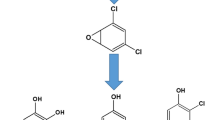Summary
Urinary hexahydrophthalic acid (HHP acid) levels were determined in 20 workers occupationally exposed to hexahydrophthalic anhydride (HHPA) air levels of 11–220μg/m3. The levels of HHP acid in urine increased rapidly during exposure and the decreases were also rapid after the end of exposure. The elimination half-time of HHP acid was 5h, which was significantly longer than in experimentally exposed volunteers, possibly indicating distribution to more than one compartment. There was a close correlation between time-weighted average levels of HHPA in air and creatinine-adjusted levels of HHP acid in urine collected during the last 4 h of exposure (r = 0.90), indicating that determination of urinary HHP acid levels is suitable as a method for biological monitoring of HHPA exposure. An air level of 100 μg/m3 corresponded to a postshift urinary HHP acid level of ca. 900 nmol/mmol creatinine in subjects performing light work for 8h. Percutaneous absorption of HHPA was studied by application of HHPA in petrolatum to the back skin of three volunteers. The excreted amounts of HHP acid in urine, as a fraction of the totally applied amount of HHPA, were within intervals of 1.4%–4.5%, 0.2%–1.3%, and 0%–0.4% respectively, indicating that the contribution from percutaneous absorption is of minor importance in a method for biological monitoring.
Similar content being viewed by others
References
Botham PA, Rattay NJ, Woodcock DR, Walsh ST, Hext PM (1989) The induction of respiratory allergy in guinea-pigs following intradermal injection of trimellitic anhydride: a comparison with the response to 2,4-dinitrochlorobenzene. Toxicol Lett 47:25–39
Eberson L, Landström L (1972) Studies on cyclic anhydrides. IV. Rate constants for the hydrolysis of some cyclic anhydrides exhibiting ring strain. Acta Chem Scand 26:239–249
Hayes J, Daniel R, Tee RD, Barnes PJ, Chung F, Newman Taylor AJ (1992) Specific immunological and bronchopulmonary responses following intradermal sensitization to free trimellitic anhydride in guinea pigs. Clin Exp Allergy 2:694–700
Jönsson B, Skarping G (1991) Method for the biological monitoring of hexahydrophthalic anhydride by the determination of hexahydrophthalic acid in urine using gas chromatography and selected-ion monitoring. J Chromatogr 572:117–131
Jönsson BAG, Skerfving S (1993) Toxicokinetics and biological monitoring in experimental exposure of humans to gaseous hexahydrophthalic anhydride. Scand J Work Environ Health 19:183–190
Jönsson B, Welinder H, Skarping G (1991a) Hexahydrophthalic acid in urine as an index of exposure to hexahydrophthalic anhydride. Int Arch Occup Environ Health 63:77–79
Jönsson B, Welinder H, Skarping G (1991b) Determination of hexahydrophthalic anhydride in air using gas chromatography. J Chromatogr 558:247–256
Lustgarten JA, Wenk RE (1972) Simple rapid kinetic method for serum creatinine measurement. Clin Chem 18:1419–1422(Modified by Masson P, Dept of Clinical Chemistry, University Hospital, Lund. Pesonal communication)
Moller DR, Gallagher JS, Bernstein DI, Wilcox TG, Burroughs HE, Bernstein IL (1985) Detection of IgE-mediated respiratory sensitization in workers exposed to hexahydrophthalic anhydride. J Allergy Clin Immunol 75:663–672
Nielsen J (1992) Airways' effecs in workers exposed to organic acid anhydrides. Dissertation. ISBN 92-628-0678-5, Lund University
Palacian E, Gonzalez MP, Pineiro M, Hernandes F (1990) Dicarboxylic acid anhydrides as dissociating agents of protein-containing structures. Mol Cell Biochem 97:101–111
Pfäffli P, Savolainen H (1991) Determination of 4-methyl-cis-hexa-hydrophthalic anhydride in human blood by gas chromatography with electron-capture detection. Analyst 116:1333–1336
Pfäffli P, Savolainen H, Keskinen H (1989) Determination of carboxylic acids in biological samples as their trichloroethyl esters by gas chromatography. Chromatographia 27:483–488
Venables KM (1989) Low molecular weight chemicals, hypersensitivity, and direct toxicity: the acid anhydrides. Br J Ind Med 45:222–232
Wass U, Belin L (1990) An in vitro method for predicting sensitizing properties of inhaled chemicals. Scand J Work Environ Health 16:208–214
Welinder H (1991) Occupational airways hypersensitivity to some small organic molecules. Exposure, response, and pathomechanism. Dissertation. ISBN 91-628-0173-2, Lund University
Welinder H, Nielsen J (1991) Immunologic tests of specific antibodies to organic acid anhydrides. Allergy 46:601–609
Author information
Authors and Affiliations
Rights and permissions
About this article
Cite this article
Jönsson, B.A.G., Welinder, H., Hansson, C. et al. Occupational exposure to hexahydrophthalic anhydride: air analysis, percutaneous absorption, and biological monitoring. Int. Arch Occup Environ Heath 65, 43–47 (1993). https://doi.org/10.1007/BF00586057
Received:
Accepted:
Issue Date:
DOI: https://doi.org/10.1007/BF00586057




